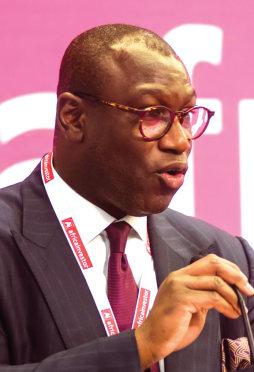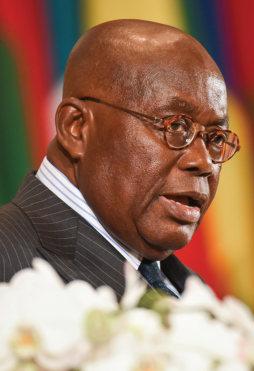
9 minute read
Profile
Public and private partnerships are key to unlocking capital for successful mining projects.

Hubert Danso, CEO of Africa investor (Ai), an institutional investment platform, and chairman of AU’s Continental Business Network, talked to delegates at the Africa Mining Forum on how to attract investment in mining in Africa.
“The continent’s potential to be a global mining investment haven cannot be disputed, when Africa is home to 90% of the world’s platinum supply, 90% of the world’s cobalt supply, 50% of the world's gold supply, 35% of the world’s uranium, 9.6% of the global oil output, two thirds of the world’s manganese, and 75% of the world’s coltan supply,” said Hubert Danso, CEO of Africa investor (Ai) while addressing delegates at the Africa Mining Forum on 16 November on the topic “The Next Smart Move: Covid-19 Recovery Plan to Stimulate Investment into Mining Exploration in Africa”.
Despite the continent’s huge resources, Danso stressed less than 50% of the continent has been geologically surveyed, and estimates that at least the same amount of resources have yet to be explored today.
But Africa only received less than one third of the US$3bn global exploration investment last year.
“We believe Covid-19 offers a unique opportunity to apply different approaches; public and private partnership models especially can better attract global and domestic shareholders, as well as innovate and assist the continent’s mining sector, support Africa’s integration and competitiveness in the global Fourth Industrial Revolution,” Danso stated.
“First and foremost, we need to appreciate that the cheapest form of stimulus is confidence, and the ability to provide confidence and clear signals to the investment community is paramount and is really very important. We believe that there is a great opportunity to reset the public-private mining leaders relationship through private sector and presidential mining investment partnerships and collaboration, and we have seen it work effectively throughout the African Union through the Presidential Infrastructure Champions Initiative currently chaired by President Cyril Ramaphosa.
“We think we can have something like that level of leadership focus on the mining sector. The African Union has a programme with institutional investors called the 5% Agenda, which is a commitment between African heads of state in governments and African pension and sovereign wealth funds to increase their allocations in the region of 5% of all assets under management to infrastructure and long-term assets. We believe the mining sector is ripe for participation in that portfolio opportunity, and we’ve already seen a very good example from Ghana, under the leadership of Nana Akufo-Addo, President of Ghana, who is working closely with the Ghananian Infrastructure Investment Fund, which has now started to invest in the gold mining sector in the country. That has really sent a very positive signal to institutional investors. We can already begin to see this model taking form in other countries on the continent.
“As a consequence the president has gained a great deal of confidence and support as a champion of the mining sector in Ghana and across the continent. But let’s remember fundamentally capital markets and private equity investments are capital raising venues and instruments whose

Hubert Danso, CEO of Africa Investor.
investments are made through companies and determined on their ability to build up a shareholder base and share premiums in terms of equity. Investment in the sector is very complex, competitive, and it is forensically compared to global peers, not just African opportunities.”
He also stressed that investors are harder to find than actual good projects, which likewise are difficult to discover. “We feel that the continent only needs to cultivate a cluster of real catalytic investors to mount a strong build back better, resilient mining investment Covid-19 response. The reality is it is easier to secure current investors and local producers to increase and expand their investment rather than secure new investors. However, it is easier to get new investors with the support of current investors and local producers. We, therefore, feel that a compelling Covid-19 mining sector response to attract investment into the mining sector should be in the form of a government partnership with local producers, premised on a fourpoint plan to optimally increase investment.” This plan involves: • working with government and local producers to expand existing mines • assisting local producers to purchase new mines • bringing in new joint venture partners to invest in that growth • intentionally targeting and attracting a larger percentage of the global exploration spend. He continued, “There is a strong and unique opportunity now for governments to work with local producers and the investment community in partnership. We, in the private sector, wherever we are going to invest, in whichever sector, the first conversation is with the local producers and local private sector to ask how they are being treated, what the opportunities are for growth, and what the nature and the depth of the relationship is with governments. HE Francis Gatare, CEO at Rwanda Mines, Petroleum & Gas Board (RMB), has already seen fruit because of the leadership delivered through his own ministry, and his president being a very dynamic leader, who understands the private sector. I really believe that partnership is something that should not be underestimated, it should be a forward looking partnership. There is a big world out there but I think with that partnership, and taking into account our blessed endowment, naturally we are well ahead of most competitors around the world. We just need to facilitate that partnership which will unlock unprecedented levels of capital, if it is properly cemented.” ■
Image Credit: International Labour Organization /Flickr

Nana Akufo-Addo, President of Ghana has been praised as a champion of the mining sector in Ghana.
By Samantha Payne


Zambia: Southern Africa’s emerging impact investment market
Zambia is gaining visibility and attracting increased investor interest as an emerging impact investment location in Southern Africa with continuing efforts to strengthen the country’s impact investing ecosystem underway.
The newly formed National Advisory Board (NAB) on Impact Investing for Zambia –recognised by the Global Steering Group (GSG) at its annual summit in 2019 – is spearheading efforts to bring more investable opportunities to the table, raise investor awareness of Zambia, build local intermediation capacity and advocate for better impact investment regulation. In partnership with the NAB, the UKAid-funded organisation, Prospero Zambia, is working to provide the financial and technical support required to bring the impact investment revolution to Zambia.
NABs have become the go-to resource for promoting impact investment. By bringing together governments, investors, asset managers, intermediaries, NGOs, and market builders such as professional firms, NABs are powerful change agents for developing impact economies that benefit people and planet. They have demonstrated their potential to unlock new sources of impact capital and develop national impact infrastructure and policies.
The launch of the NAB in Zambia comes at critical time when the country needs more impact capital to achieve the 2030 SDGs and finance its Seventh National Development Plan (7NDP). The Africa 2030 plan for reaching the SDG requires a minimum financing of US$500bn annually (SDGC Africa, 2019).
Its purpose is to lead efforts to bring more investable opportunities in Zambia, raise impact investing awareness, build local intermediation capacity and advocate for better impact investment regulation. NAB aims to become an influential cross-sector coalition aimed at driving capital to improve lives and the environment.
“Zambia needs to increase the level of investments in its impact sectors five-fold to US$5bn per year in order to achieve the SDGs by 2030. This corresponds to 1,000 new investments per year when applying the average historical deal size. This illustrates the interventions required within the Zambian impact investment ecosystem,’’ said NAB.
The country is well-known for its copper-based raw-material exporting economy; but economic diversification and increasing investment in value addition are accelerating as businesses serve a growing and urbanising population.
SMEs specialising in activities such as food processing, solar energy and other renewables, and conservation tourism are major players in a new generation of Zambian businesses that have successfully raised impact finance to support business growth.
Over the last two years, Prospero Zambia has been working with such businesses to make them investment ready – guiding them through the process of preparing for due diligence, meeting potential investors and negotiating deals.
“The vision for Zambia is that it will emerge as a regional hub for impact investment in the region –surrounded as it is by other early stage but highly potential markets, such as Botswana or DRC. There is a long way to go, but the ambition is clear, and investors more familiar with Nairobi or Cape Town are starting to pay attention,” said NAB.
The NAB is working with private sector and government stakeholders to promote lasting change in the impact investment ecosystem to allow more deals to be done – vital for growth of the country.
The Zambian impact investment market is expected to increase at a Capital Annual Gross Rate (CAGR) of 13% towards 2023.
Macro-economic challenges
Although the outlook for investment is positive and there are so many opportunities, the macro-economic situation is in a quagmire. Emerging markets are not popular with investors in a period of declining global growth. In Zambia, the interest rates are rising with the increased indebtedness of the country. The reduced foreign currency reserves led to a liquidity crunch, which has had a knock-on effect in the finance sector and beyond. Inflation is rising and the Zambian Kwacha is under constant devaluation pressure.
Furthermore, power is out for half the day, reducing many productive hours of SMEs and the service industry while the price of fuel is expensive. The Zambian economy is small with 17 million people sharing a GDP of US$5bn. The mining sector accounts for more than 12% of that GDP, according to the World Bank. There is also an uneven Gini coefficient (representing the wealth inequality within a nation), which is very high and points to a small base of spenders in the country. Not surprising that Zambia slipped in the global competitive index to 120 out of 141 countries.
On top of all that, is the ongoing impact of Covid-19 on investment. In GSG’s new policy paper, it identifies three core phases: emergency, recovery and renewal.
“If our objective is to stop the pandemic, we need entrepreneurial innovation to deliver vast quantities of effective tests as soon as humanly possible,” said GSG chair, Sir Ronald Cohen. ■

